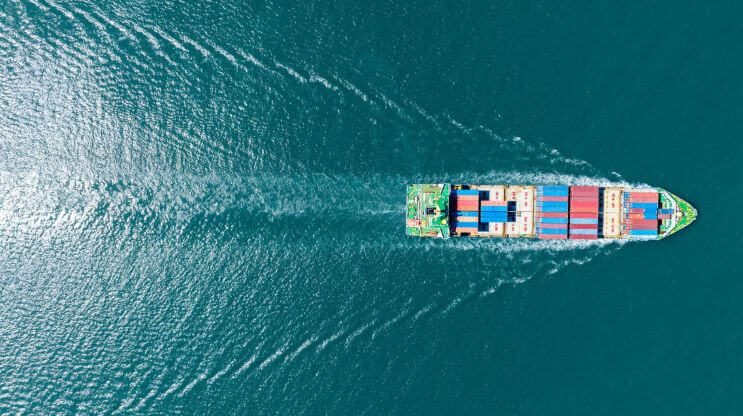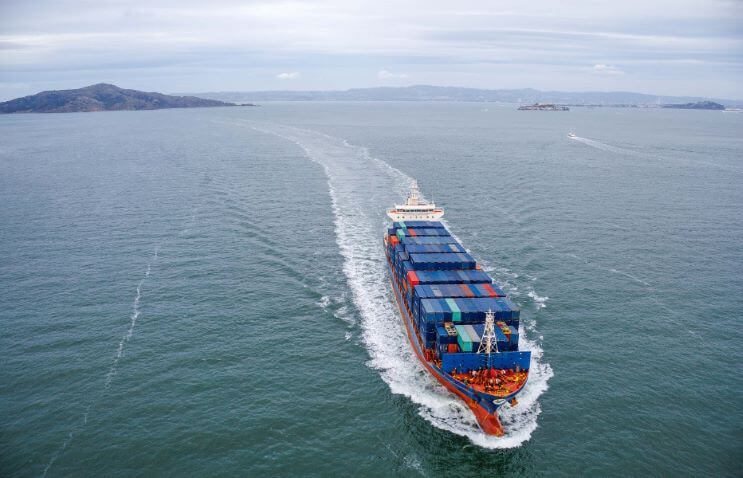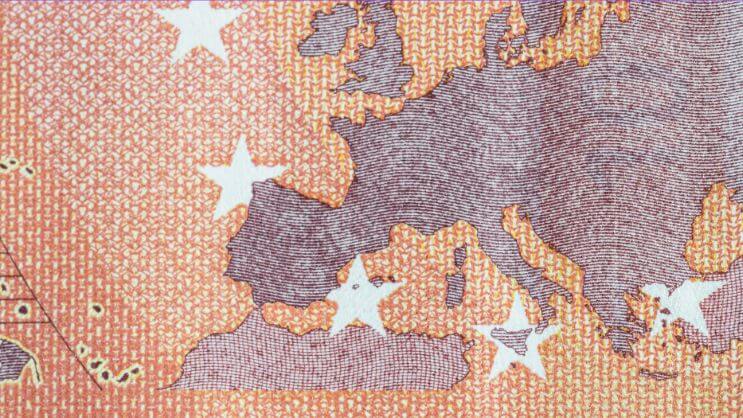Short-sea shipping
Nowadays, taxes, restrictions, idle times, finances, the shortage of carriers, and many other problems make it necessary to look for alternatives to replace road transport. We have written about the pros and cons of road transport before. Today, we will talk about short-sea shipping.

Source: www.canva.com
Short Sea Shipping (SSS), better known in English as SSS, solves the above-mentioned disadvantages as well as offers time and cost savings. In addition, transport planning is improved through cooperation between ports in order to achieve barrier-free maritime transport in Europe.
What is SSS?
SSS requires a simple definition to make it understandable and “friendly” for its future users. It refers to the term freeways of the sea. A freeway of the sea is understood as the maritime segment connecting two ports, which in turn are linked to trans-European networks and intermodal corridors. They cover all movement of cargo and passengers, mainly by sea along a coastline, without crossing an ocean.
In Spain, for example, many of the maritime transport services between the Canary and Balearic Islands and the Iberian Peninsula fall within the European concept of short-sea shipping and stand out for their regularity and high frequency.
SSS offers services and each case will require a specific treatment. They offer intermodal logistics solutions to the needs of different types of customers (and their goods) in intra-European trade.

Source: www.canva.com
To promote the development of short-sea shipping, it is essential to enhance the intermodal characteristics of transport systems, i.e. the complementarity of maritime and land modes.
In this regard, regular ro-ro (roll-on/roll-off) maritime services are particularly relevant, in which road transport uses maritime transport as an alternative infrastructure to road transport, facilitating the loading and unloading operations of trucks or semi-trailers compared to lo-lo (lift-on/lift-off, loading and unloading of containers) operations.
How can I find out about these offers?
Regardless of the fact that each company offering international intermodal transportation services has its own sales force,
if you do not know each provider of this type of transport, there are several pages that can help you find the different routes and services offered by each shipping company. For example, there is a page to compare road transport with SSS to evaluate which type of transport is more profitable. Here is the link to one of them: ShortSea (in Spanish). You simply enter the port from which you want to send cargo and the port where you want it to disembark, then the simulator offers you a series of useful information to carry out the transport. From this page, you can also keep up to date with the latest news concerning SSS and learn more statistics about this transport.
Who should I contact? Who do I ask for a quotation?
When selecting the service or before obtaining a quotation, you will have to provide data such as the following:
- Weight,
- Dimensions,
- Country of destination,
- City of destination,
- Type of merchandise,
- If it needs any special attention and how it should be packed or loaded on the truck,
- If the cargo is considered to be Dangerous Goods, add the IMO / ADR description of the Dangerous Goods,
- Planned dates of pick-up at origin and delivery at destination (if door-to-door service).
From there, you will be able to compare your needs with the services offered.
You can request detailed information to analyze whether the sea leg links and fits into your logistics chain as required. The shipping company will tell you, if necessary, the procedure and documentation required. You will also be able to decide the degree of involvement you wish to assume in the transport logistics chain. If you choose to entrust the entire management to a third party, you can rely on a logistics operator.

Source: www.canva.com
But who is the logistics operator?
Any company that, with the corresponding administrative authorizations, assumes in its own name the management, responsibilities, and control of the transport chain. In the case of “door-to-door” SSS, this work can be carried out by the Shipping Company’s agency (for its own line), as well as by the Forwarder or the International Transport Company. In the latter two cases, they will choose from the shipping lines offered by the shipping lines the one that best suits the shipper’s needs. More information about third-party logistics can be found here.
Most relevant routes
Euro-Mediterranean Arc, where there are already regular short sea shipping services oriented to road transport with daily frequencies, proves its technical-economic feasibility and its potential for future development. Currently, more than 4 million tons of trucks are diverted through these maritime services instead of through border crossings, particularly the La Junquera crossing.
Atlantic Arc, with the European ports of the North Atlantic Arc (including the North Sea) currently having the highest concentration of cargo due to their proximity to the major areas of production and consumption. They offer good possibilities for consolidating existing short-sea shipping services with other more peripheral ports, such as those located on the Cantabrian coast of the Iberian Peninsula.

Source: www.canva.com
What type of products is it intended for?
The range of types of transportable goods is very wide, not to say that any goods can be transported. There is a wide range of shipping methods for different types of goods. For example, products that are usually transported in bulk can be transported directly in the hold of a ship, in a tank trailer, in a tank container, or in a dry container with a flexi tank.
The goods to be palletized may travel in a semi-trailer or in a container. To know how to optimize the bulk cargo in the container, you can use the software EasyCargo with a free trial, or in the warehouse if you are working with large volumes. Fruits, vegetables, beverages, and other food products are usually shipped by trailer, semi-trailer, or reefer container.
Is my merchandise traveling safely?
It is important, as in the case of road transport only, to load the trailer, semi-trailer, or container with the most appropriate lashing measures depending on the goods. In the maritime route, there is a protocol for lashing and securing the trailer, semi-trailer, container, or goods to the ship, which is carried out by specialized personnel.
When should the goods arrive at the port?
Following the instructions of the shipping company or logistics operator you have selected, the arrival time for goods operating within the European Union is generally 1 hour before the scheduled arrival time of the ship. For trucks with or without traction heads for Ro-Ro vessels, the equivalent for containerized goods. In the case of international cargo, when it is a large volume of tons, the reception at the port must be completed a few hours before the start of loading the vessel to carry out the loading in the right order.
Do I have to complete any customs formalities?
Not if the goods are goods within the European Union going to or coming from the European market, except if the shipping line does not have regular line status from the customs point of view, in which case it will be sufficient to send the consignee/logistic operator a copy of the commercial invoice so that he can include it in the documentation to be delivered to Customs.
If the shipment is to a country outside the EU, you will have to carry out the same procedures as if the shipment were by road, either directly with Customs (if you have the corresponding authorization) or by contacting a representative (customs agents or freight forwarder) to file the customs declarations.
Statistics
In order to evaluate the potential development of short sea shipping in Europe, it is necessary to refer to the corridor connecting the Iberian Peninsula with the rest of Europe, through which the goods that Spain and Portugal export to or import from the rest of the European continent are transported. As in other corridors, the road has acquired a strong role in these flows, especially after the signing of the Accession Treaty between Spain and the current European Union at the end of 1985.
In that year, growth rates rose from 2.8% to 8.4%, a figure that has been maintained, currently generating a traffic volume of around 120 million tons in both directions. This translates into average daily intensities of approximately 20,000 trucks through the border crossings of La Junquera and Irún, with the consequent external effects derived from congestion. Therefore, the development of regular short-sea shipping services oriented to road transport is undoubtedly a sustainable mobility alternative.
Short-sea shipping represents a business opportunity, especially in view of the possible creation of a Mediterranean free trade area or the implementation of the common European maritime space without borders, which will eliminate obstacles to the development of this type of service and will increase its quality/cost ratio, making it more competitive.
Step-by-step operation
After receiving confirmation from the shipping company that will carry out the transport, a series of steps must be followed to complete the purchase and sale operation:
- First, you have to load the goods on the truck that will be in charge of transporting them from the origin to the port of departure of the ship.
- Upon arrival at the port, the goods must pass through customs.
- Customs responds automatically and the circuit is assigned prior to the ship’s arrival.
- The assignment of one or the other circuit is made by combining statistical models and other parameters that also include random controls.
- There are 3 models of circuits: green, which allows for the immediate release of the goods without any review, neither physical nor of the accompanying documentation.
- Orange, the documentation will be reviewed and checked.
- Red, this circuit involves a physical recognition of the shipment.
- In addition to reviewing the documents, the customs authority will move the container to a border inspection point to inspect whether the data we have reflected in our declaration coincides with reality.
- If everything is in order, the goods will be dispatched.
- After passing customs control, the main transport of the goods from the port of departure to the port of destination will begin.
- Finally, the arrival at the port of destination and then to the customer’s warehouse.
European Union’s support
The promotion of Short-Sea Shipping on a purely national level would not be sufficient due to the door-to-door conception of international transport. Promotional and information actions must be developed in a coordinated manner at both ends of the chain.
The European Union intends to promote multimodal transport in the European territory through the European Short Sea Network (ESN).
The Association was created with the intention of facilitating the development of competitive multimodal transport chains with the relevant participation of the maritime mode. This is one of the challenges that the maritime sector has set itself, under the auspices of European Union projects, with a view to lowering costs, reducing time, and contributing to the preservation of the environment in a more efficient manner. The idea is to create alternative routes that combine truck traffic by road, train, and river transport with maritime corridors that clear land routes for the collective benefit.
Today more than 15 European countries (Germany, Ireland, Portugal, etc.) and 25 Spanish ports (Port Authority of Barcelona, Bilbao, Vigo, Huelva, etc.) support and promote this mode of transport as well as European and national institutions and organizations such as “Marco Polo Program”, “Shortsea XML”, “MITMA”.

Source: www.canva.com
The extensive documentation on this subject, mainly at the level of the European Union, distances it from what it really is: an everyday activity in which bidders and offerors are in full competition as a matter of course.
In conclusion, we can summarize the content of the article by knowing a new type of transport as the SSS and, in turn, know how it is possible to make use of it. Also, we now know what advantages it has over other modes of transport and what needs are required at the time of starting the operation.
Author of the article: Julian Vieiro Gonzalez




